Tag Archives: bed
Movies in Bed: Walking With Monsters: Life Before Dinosaurs
Post by Mark T. Locker.
When all the dinosaur shows have been watched (and watched and watched) but still you (or, more likely, your offspring/niece/neighbor) still long for more prehistoric CGI action, you can rest easy! Brought to you by the same chaps at BBC who created the much-lauded Walking With Dinosaurs series have a trilogy shining a light on the creatures who began all the fun. Beginning with my kid’s favorite (announced in a dramatic British accent): ARTHROPODS. For the uninitiated, that means scorpions and spiders and other fun things. Now, picture them the size of a Volkswagen and crawling out of the sea. ARTHROPODS.
This show follow the dinosaurs’ predecessors from the first fish to the dimetrodons, which I always thought were dinosaurs but apparently aren’t. My father-in-law, the eminent non-paleontologist grumbled, “Is it bigger than a dog? Then it’s a dinosaur!” Although I like his philosophy, I had to argue that elephants are bigger than dogs too. ANYWAY…if you or someone you love digs prehistoric creatures and you can handle the brutal truth of life in the Cambrian and early Permian periods, find this series streaming online. It’s fun and less played than the old dinosaurs.
Things We Like: Sleeping Positions For Better Health

Post by Kyle St. Romain.
We all know that it’s important to get a good night’s sleep, and we’ve posted dozens of articles here on the Charles P Rogers blog to help you do just that. Today, we’re going to discuss another important element of a good night’s sleep: the position you sleep in. Keep reading below to learn more about how the most common sleep positions affect your health (and what they say about your personality).
The “soldier”: Flat on your back with your arms at your sides.
Widely considered the best sleeping position, lying on your back with your arms at your sides promotes a healthy spine and neck. However, people who sleep on their backs tend to snore more than others. Solider sleepers are usually more reserved, quiet, and have higher standards for themselves and others.
The “log”: On your side with both arms down.
The log is generally considered a good sleeping position; however, it can cause some neck pain as your shoulders put your head at an angle down towards the pillow. Loggers and are usually thought of as being easy going and sociable.
The “starfish”: Flat on your back, with your arms overhead.
Similar to the log position, starfish sleepers lie flat on their backs. Instead of leaving their arms at their side, however, starfish sleepers put them above their head — either on top of or underneath the pillow. While this position also promotes good spine alignment, some people may experience shoulder/neck pain over time due to the extra pressure put on the shoulders. Starfish sleepers tend to make good friends, and are good listeners.
The “freefall”: On your stomach, face down.
Sleeping on your stomach is said to help with digestion; however, it restricts breathing. After all, it’s pretty hard to breath through a pillow. As such, many people who sleep on their stomachs tend to tilt their head to one side or another which can put a lot of strain on your neck and back. This strain also causes many freefallers to experience restlessness, as they constantly adjust throughout the night in search of comfort. Freefall sleepers are typically brash and outgoing, but do not take criticism well.

The “fetal position”: Curled up in a ball on your side.
The fetal position is the de facto for comfort, and is by far the most popular position people sleep in. After all, it is the position we were first created in. If you’re having trouble with snoring or are pregnant, the fetal position may provide you with temporary relief. While the fetal position may seem like the most comfortable way to sleep, it can wreak havoc on your neck and back, and also restricts deep breathing. People who sleep in the fetal position are said to be tough on the outside and soft on the inside.
The “yearner”: On your side with both arms out.
Similar to the log, the yearner position is another popular sleep position. The yearner differs from the log in arm placement: they are stretched out in front, rather than being kept at your side. Yearners tend to be stubborn yet open-minded.
So if you’re looking for a better night sleep, you may want to try changing your sleep position. A new sleep position can not only help you sleep better, but can also help you stop snoring (which means your spouse will sleep better) or even get rid of that lingering pain in your neck.
Breakfast in Bed – Brown Butter Eggs

Post by Alison Hein.
Brown butter is a delicious and decadent way to dress up a dish. I love it on top of butternut squash ravioli, with some toasted fresh sage tossed in. And one of my very favorite dishes growing up was, believe it or not, cauliflower. My mother would cook the cauliflower, then melt up a big wad of butter and keep it on the heat until it turned a rich, bubbling brown. The final step was to add plain breadcrumbs, and stir them around until they reached the same lovely brown color, and the deep, nutty flavor of the butter. Then she spooned the breadcrumbs over the cauliflower to make a superb side dish.
Well, how about applying that same principle to eggs? It’s best to cook them simply – boiled, poached, or baked – and then let the nut-brown butter add all the depth and flavor. In this recipe, a drop of butter and dash of breadcrumbs has been added to the bottom of the baking dish for a heartier feel.
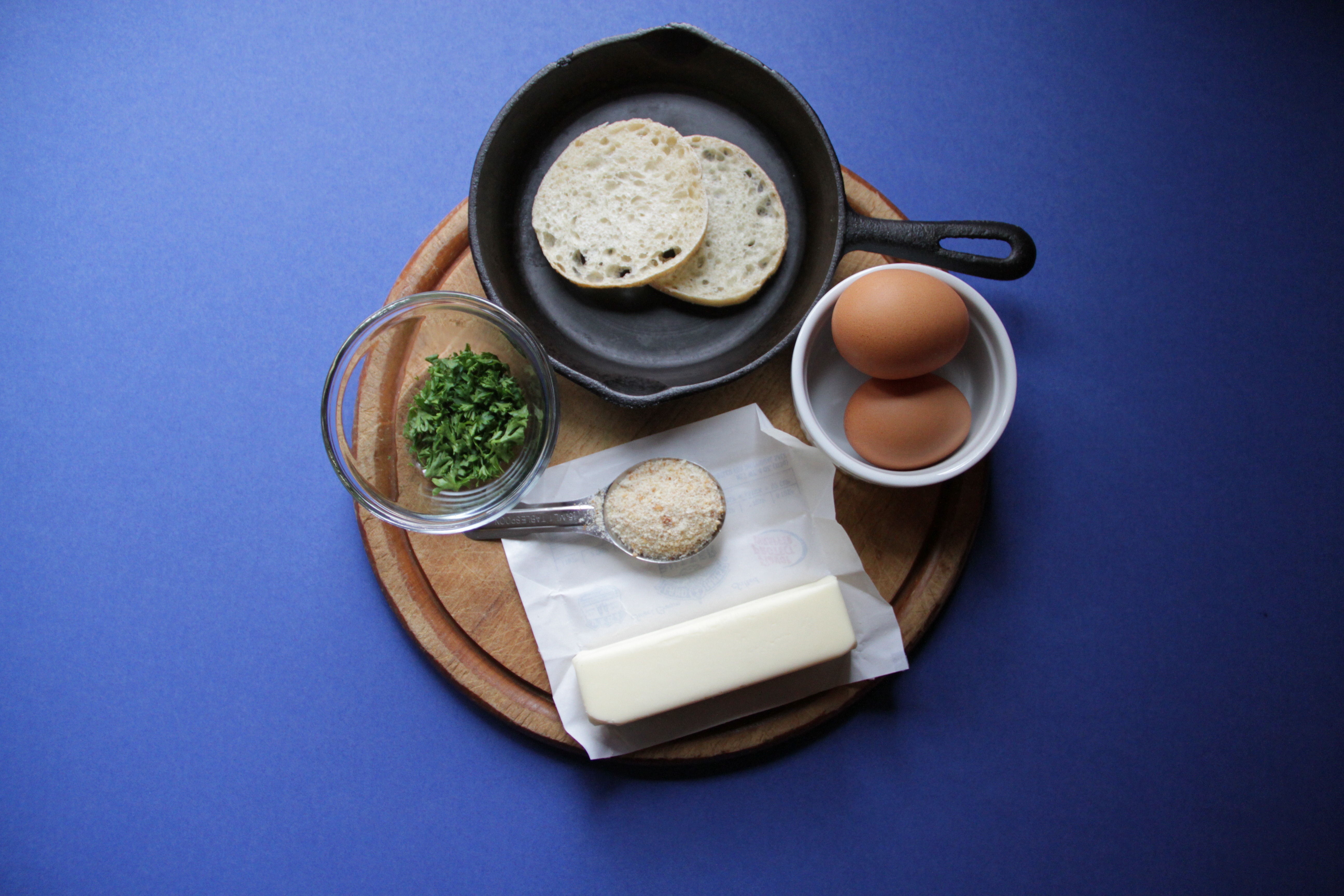
I recently learned that adding vinegar while heating the butter helps it to brown deeply and evenly. No need to butter your toast rounds – simply dip them right through the buttery layer deep into the heart of the eggs for a delicious and decadent breakfast in bed.
Ingredients
3 tablespoons butter
2 tablespoons breadcrumbs
4 eggs
Salt and pepper, to taste
1 teaspoon cider vinegar
4 slices of sourdough bread
1 teaspoon fresh curly parsley, chopped
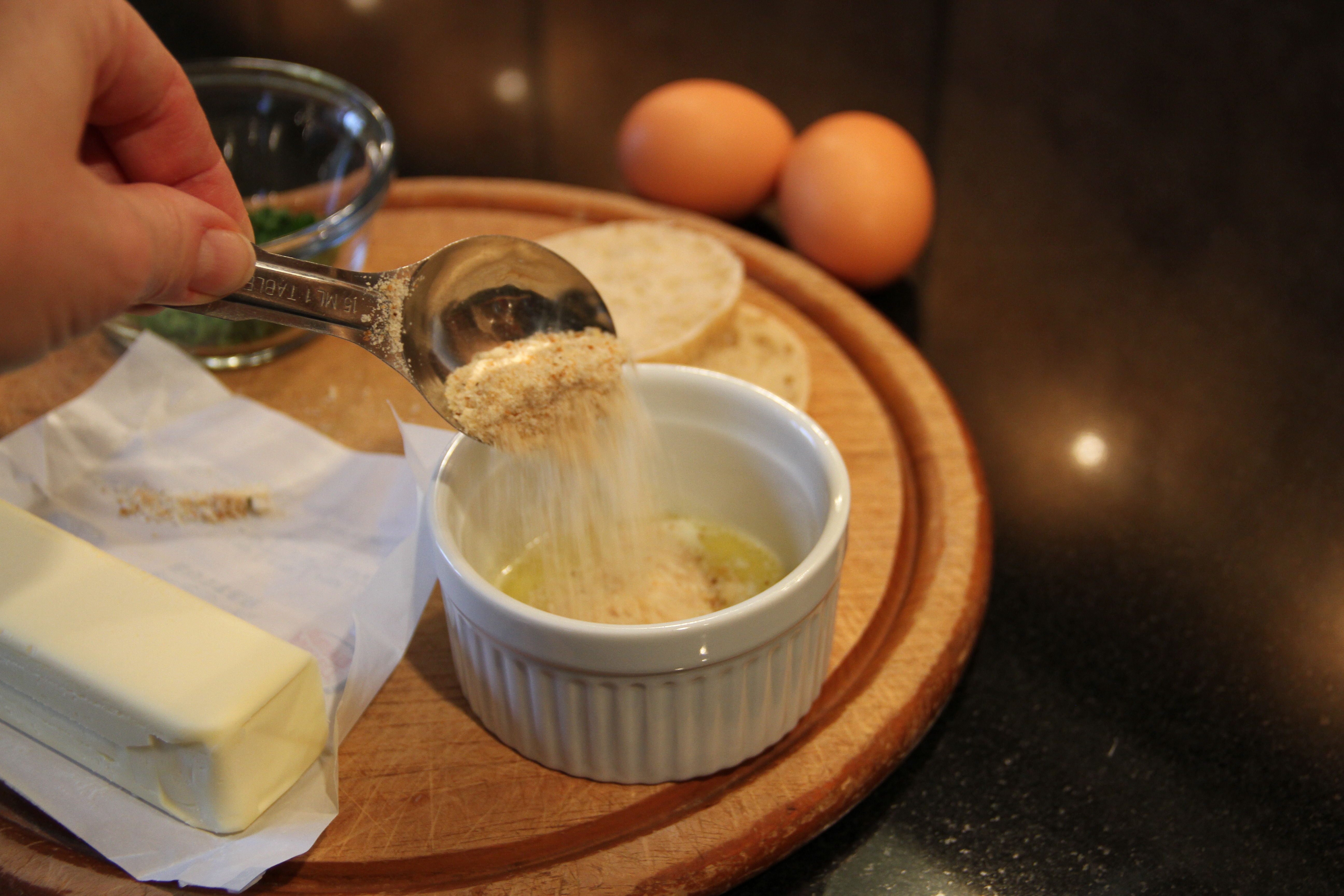
Preparation
Preheat oven to 350°. Melt one tablespoon of butter and pour equal amounts into two small ramekins. Pour an even layer of breadcrumbs on top of melted butter in each ramekin. In a separate small bowl, carefully break eggs one at a time. Make sure the yolks are intact, then pour the eggs one by one into the ramekins, two eggs in each. Season with salt and pepper.
Place ramekins in a baking dish which has been filled with about 1 inch of warm water. Place baking dish in oven, and bake about 20 to 25 minutes until egg whites are firm.
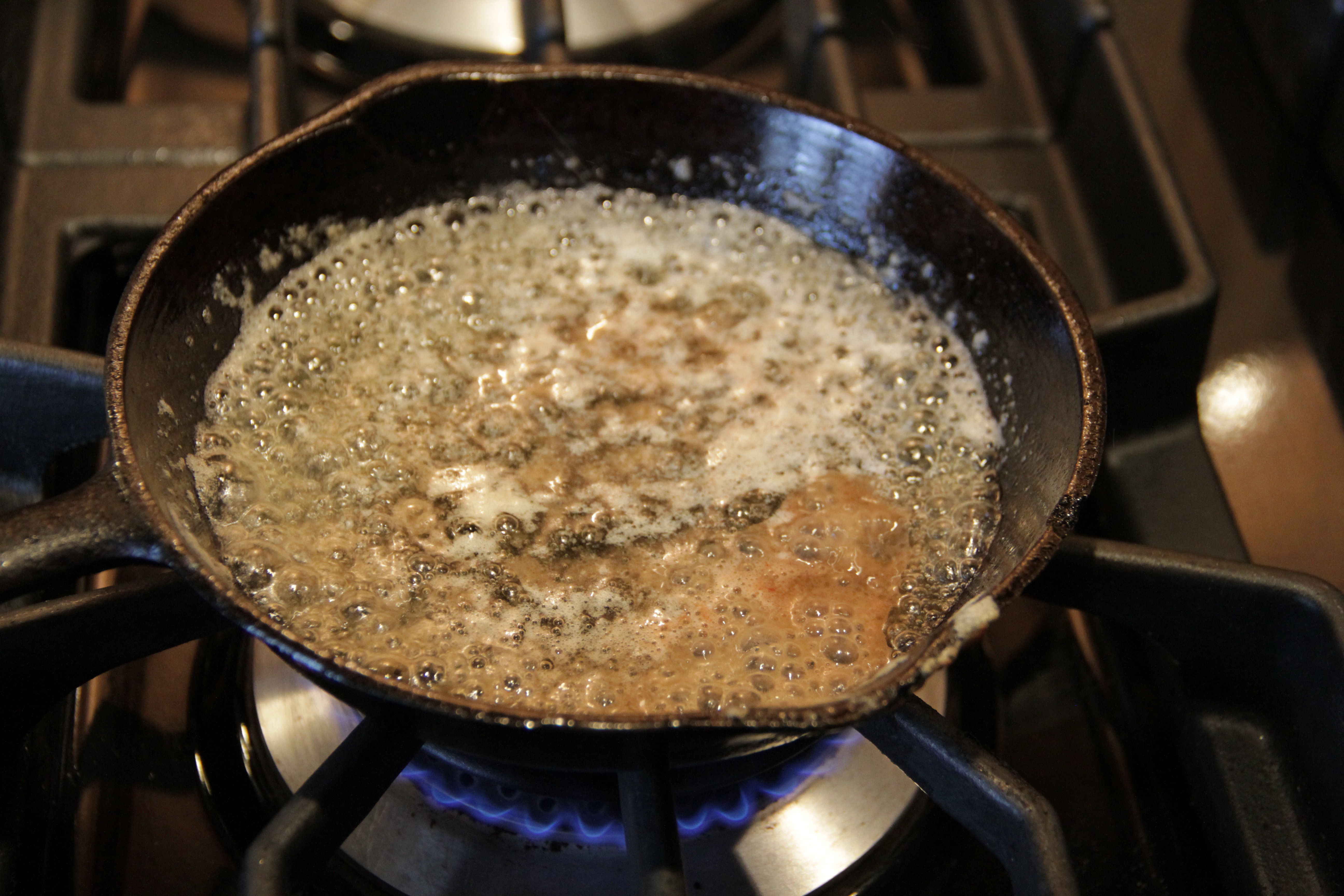
Toward the end of baking, cut the sourdough bread into four rounds and toast until golden brown. Melt the remaining butter in a small pan over medium heat. Continue to cook for a minute or two until the butter starts to bubble. Stir in vinegar and continue to cook for another minute or so.
Pour brown butter equally over each of the two baked egg ramekins, and top each with half of the chopped parsley. Serve hot with toast rounds.
Makes 2 servings.

Things We Like: Fresh Juice in the Mornings
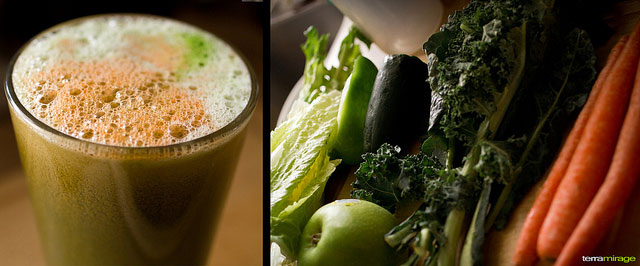
Post by Kyle St. Romain.
Over the past couple of months, one of the things I’ve really come to look forward to in the mornings is fresh juice. So much so that it has quickly become part of my morning ritual. As we’ve looked at in past articles, motivational morning rituals can help you look forward to getting out of bed and starting your day the right way. In the past, a good cup coffee did it for me; however, fresh juice has proven to be even more satisfying.
Health Benefits of Juicing
One of the problems many people have with their diet is that they don’t eat enough vegetables. The good news is that adding fresh juice to your diet quickly solves this. Proponents of drinking fresh juice tout that it can reduce your risk of cancer, boost your immune system, help detoxify your body, aid in digestion, and even help you lose weight. In fact, there is a very specific juice regiment known as the Gerson Therapy that has shown positive results.
The one thing you don’t get from drinking juice vs. eating whole fruits and vegetables is the fiber. Your body also misses out on some of nutritional content from the produce; however, you can consume a lot more fruit and vegetable in juice form than you could eating them whole. Proponents view the lack of fiber as a good thing, giving your body less matter to have to process.
Whatever the studies show, I find that juice is a very clean form of energy. Unlike anything else I’ve ever ate or drank. It gets me going on the morning, and makes me feel great. The one downside about juice is that when the energy runs out, you really hit empty. It’s kind of like a sugar crash, and the empty pit in your stomach will tell you its time to eat something solid. That said, I’ve found that eating eggs or some other form of protein with the juice gives you more lasting energy.

Choosing A Juicer
There are a lot of different types of juicers you can chose from, and I spent a lot of time researching the one I thought would be best. The two broad categories of juicers to choose from are centrifugal and masticating.
Centrifugal juicers are the ones you’re most likely to find at a health store or juice bar. They extract juice from fruits and vegetables very quickly, but are not as good with leafy greats like Kale or Wheatgrass. They are also harder to clean, and can have expensive parts that you’ll need to replace over its life.
The other type of juicer, and the one I ultimately went with, is a masticating juicer. Instead of extracting the juice through centrifugal force, an auger slowly grinds up your fruits and vegetables to extract their nutritional goodness. It takes a little more time to chop up the produce small enough to fit in the juicer, but they are much easier to clean. I’m better with a knife than I am with washing dishes, so this was a big selling point for me. Masticating juicers are also better with leafy greens. They also process the produce at a lower speed, which many believe results in a more nutritional juice.
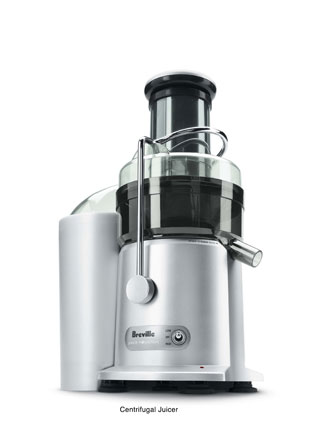
Juice recipes to get you started
If you’ve decided to take the plunge into the world of juice, which I strongly recommend you try, you’ll have a lot of time to perfect your own favorite recipes. To help get you on the right track, below is my every day juice recipe, which makes enough juice for 2-3 people. You can easily cut the recipe in half if you’re juicing for one.
- 4 Granny Smith Apples
- 6-8 Carrots, depending on how you’re feeling
- 2 inch cut of fresh Ginger
- 1 Lemon
- 1 Lime
- 1 Cucumber
- 1 handful of fresh Kale
When blueberries are in season, I also like to make what I call an antioxidant booster once per week. This recipe calls for:
- 2 pints of Blueberries
- 1 container of Pomegranate seeds
- 2 Oranges
- 1 Lime
Again, the above recipe makes enough for 2 people and can be halved for one.
So there you have it, just about everything you need to know to get started juicing. It is probably the best lifestyle change I’ve made for myself, and a number of my friends who’ve jumped on the juice wagon agree. Juicing is also inexpensive out here in California where fresh produce is abundant. On average, we spend $10-$20/week on produce which makes enough juice for 2 people 5 days per week. It’s a relatively low cost considering how good you feel drinking it. And once you make the initial investment in a good juicer, the per cup cost is quite low compared to what you’d pay at a juice bar.
Until next week, cheers to your health!


